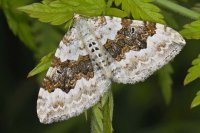Poisonous effect of Hemlock
|
Wikipedia says:
Plant
By far the more familiar species is Conium maculatum (Hemlock or Poison
Hemlock). It is a herbaceous biennial plant which grows between 1.5–2.5
metres (5–8 ft) tall, with a smooth green stem, usually spotted or streaked
with red or purple on the lower half of the stem. The leaves are finely
divided and lacy, overall triangular in shape, up to 50 centimetres (20 in)
long and 40 centimetres (16 in) broad. The flowers are small, white,
clustered in umbels up to 10–15 centimetres (4–6 in) across. When crushed,
the leaves and root emit a rank, unpleasant odour often compared to that of
parsnips.
Ecology
Conium maculatum grows in damp areas. It is used as a
food plant by the larvae of some Lepidoptera species including
Silver-ground Carpet. Poison hemlock flourishes in the spring, when most
other forage is gone. All plant parts are poisonous but once the plant is
dried, the poison is greatly reduced, although not gone completely.
Silver-ground Carpet
(Xanthorhoe montanata)
 |
Poison
Conium contains the pyridine alkaloids coniine, N-methylconiine,
conhydrine, pseudoconhydrine and ?-coniceine (or g-coniceďne), which
is the precursor of the other hemlock alkaloids. The most important and
toxic of these is coniine, which has a chemical structure similar to
nicotine. Coniine is a neurotoxin, which disrupts the workings of the
central nervous system and is toxic to humans and all classes of
livestock. Ingestion in any quantity could result in respiratory collapse
and death. Coniine causes death by blocking the neuromuscular junction
in a manner similar to curare; this results in an ascending muscular
paralysis with eventual paralysis of the respiratory muscles which results
in death due to lack of oxygen to the heart and brain. Death can be
prevented by artificial ventilation until the effects have worn off
48–72 hours later. For an adult the ingestion of more than 100 mg of
coniine (approximately 6 to 8 fresh leaves, or a smaller dose of the
seeds or root) may be fatal.
Effects on animals
C. maculatum is poisonous to animals. In a short time the alkaloids
produce a potentially fatal neuromuscular blockage when the respiratory
muscles are affected. Acute toxicity, if not lethal, may resolve in the
spontaneous recovery of the affected animals provided further exposure is
avoided. It has been observed that poisoned animals tend to return to feed
on this plant. Chronic toxicity affects only pregnant animals. When they
are poisoned by C. maculatum during the fetus's organ formation period,
the offspring is born with malformations, mainly palatoschisis and multiple
congenital contractures (MCC; frequently described as arthrogryposis).
Chronic toxicity is irreversible and although MCC can be surgically
corrected in some cases, most of the malformed animals are lost. Since no
specific antidote is available, prevention is the only way to deal with the
production losses caused by the plant. Control with herbicides and grazing
with less susceptible animals (such as sheep) have been suggested.
C. maculatum alkaloids can enter the human food chain via milk and fowl.
Such losses may be underestimated, at least in some regions, because of
the difficulty in associating malformations with the much earlier maternal
poisoning.
Socrates
In ancient Greece, hemlock was used to poison condemned prisoners. The most
famous victim of hemlock poisoning is the philosopher Socrates. After
being condemned to death for impiety in 399 BC, Socrates was given a potent
infusion of the hemlock plant. Plato described Socrates' death in the
Phaedo:
The man...laid his hands on him and after a while examined his feet and
legs, then pinched his foot hard and asked if he felt it. He said "No";
then after that, his thighs; and passing upwards in this way he showed
us that he was growing cold and rigid. And then again he touched him and
said that when it reached his heart, he would be gone. The chill had now
reached the region about the groin, and uncovering his face, which had
been covered, he said – and these were his last words – "Crito, we owe a
cock to Asclepius. Pay it and do not neglect it." "That," said Crito,
"shall be done; but see if you have anything else to say." To this
question he made no reply, but after a little while he moved; the
attendant uncovered him; his eyes were fixed. And Crito when he saw it,
closed his mouth and eyes.
|
Although many have questioned whether this is a factual account, careful
attention to Plato's words, modern and ancient medicine, and other ancient
Greek sources point to the above account being consistent with Conium
poisoning.
|